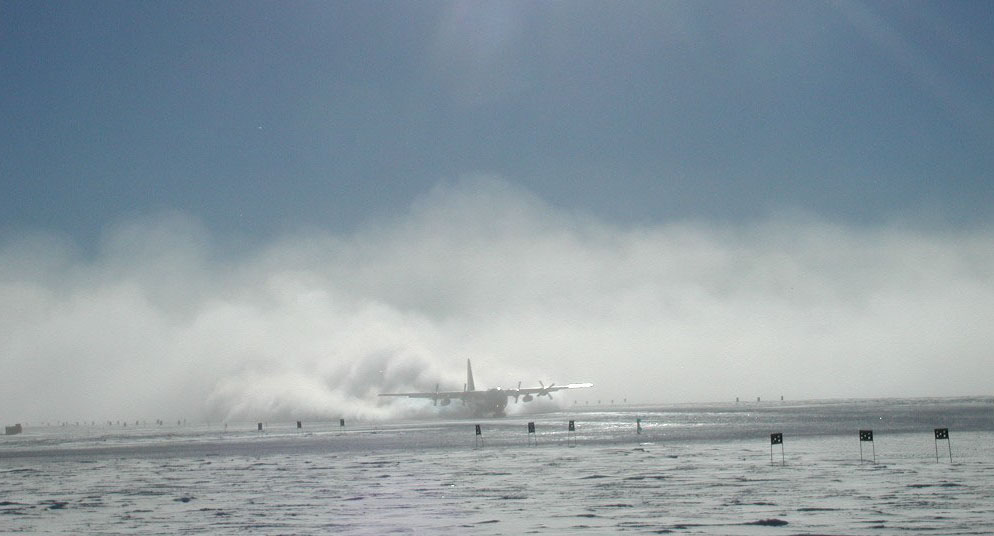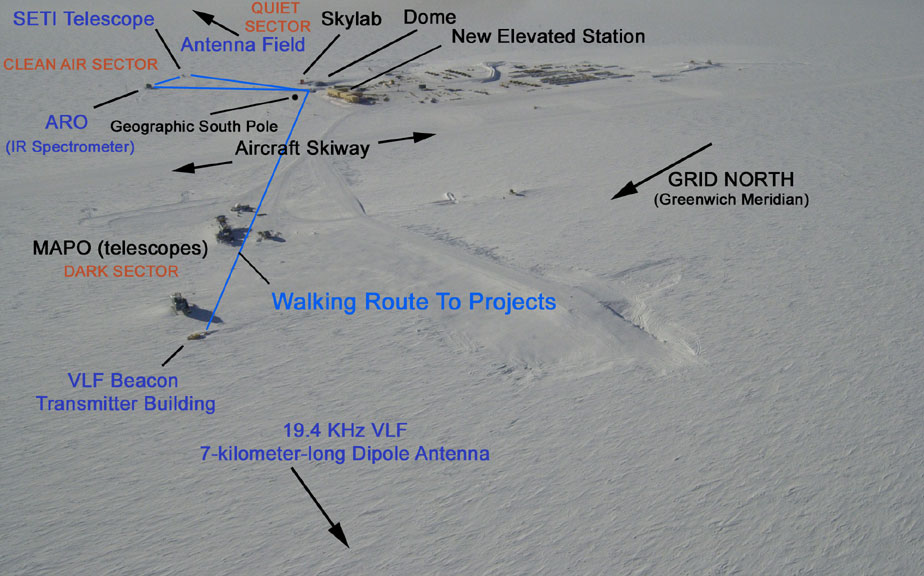
The last LC-130 aircraft until October 25th leaves heavy contrails as the last of the summer people leave the station to the winterover crew (photo by Baker)

The last
LC-130 aircraft
until October 25th leaves heavy contrails as the last of the summer
people leave the station to the winterover crew (photo
by Baker)
February at the Pole - the station
closes for almost 9 months
Summer
finally wound down and before we knew it, the last of the summer people
were leaving on that last flight on February 15th. It had been a very
hectic and constructive summer, but it was time for us winterovers to
take over the station. last of the summer
people board the last LC-130
lonely last plane (photo by unknown polie)
winterovers wave good-bye as
the
last flight for almost 9 months waves its wings
quiet galley (photo by
unknown polie)
This winter I have more projects to care for than last time and they
are spread out over a larger distance. Walking is
necessary because it is now getting too cold for snowmobiles or
other vehicles. This makes for about a 2-1/2
mile walk each day to do routine work or to attend to emergencies or
repairs. It is not too difficult right now to make the rounds everyday
while it is light out and only -50oF or -60o F, but it can
be a bit challenging once the sun sets, it is dark out for six months,
it is -80o F to -100o F and the
wind is howling with blowing snow and white out conditions.
I have
two laboratories in the orange Skylab building on the
first and second floors with 8 projects dealing primarily in upper
atmospheric physics, the VLF beacon transmitter building almost a
mile away in the "dark sector", the Infrared Spectrometer lab in
the Atmospheric Research Observatory (ARO) about 1/3 of a mile way in
the
"Clean Air Sector", and the SETI telescope tower and service building
about 1/3 of a mile away. In addition, I have 7 under ice vaults with
antennas and other instruments out in the antenna field up to 3/4 of a
mile away from the dome. And finally, there is the 7 kilometer-long
(4-1/2 mile-long) VLF dipole antenna which is located grid west about 2
kilometers from the VLF beacon building. I occasionally have to
visit the vaults that are as deep as 40 feet to make adjustments on the
instruments or pre-amplifiers. Frequently a walk to one of the
buildings results in quite a bit of snow shoveling before you can
enter. shoveling
the VLF beacon bldg

Aerial View of
Amundsen-Scott South
Pole Station showing the locations of my 11 scientific projects
Now that the station is closed and winter darkness is approaching,
a
variety of station tasks must be completed. These tasks include
removing the aircraft and station JP-8 fuel line and system and
rolling up the 1/2 mile-long hose, putting up safety flaglines to the
dark sector and the VLF beacon building, ARO, the SETI building, the
antenna field and the RF building (satellite antenna area).
(fuel line photos by Jules Harnett)
rolling the JP-8 aircraft and
station storage fuel line fuel line work
the look of cold work
exhaustion
Flagline
installation to the Dark Sector (photos by Troy Wiles)
installing flags
flagline crew
flagline (station in back
about 1 kilometer away)
One
can
readily see why a new station is being built to replace the dome which
was completed in 1975 and the South Pole accumulates only about 8-10
inches of snow per year. Dome in 1975 (bill spindler)
Dome in 2004
The
sun is
rapidly getting lower in the sky as sunset on March 20th
approaches. power plant exhaust in the
weakening sun at 8 degrees elevation on Feb. 29th
NEXT MONTH: The Sun
Sets For Six Months
A Real-Time Photo of South Pole Station as Seen from the ARO Building (live when satellite is up)
A Comprehensive
South Pole Web Site by Bill Spindler
Winterover Web Pages
(Bill Spindler's List)
SOUTH
POLE 2003-2004 HOME PAGE